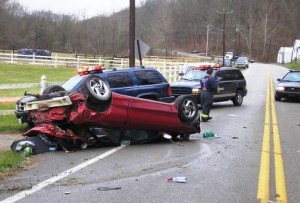Secretary of Transportation Ray LaHood today announced that the DOT is starting pilot programs in Hartford, Connecticut and Syracuse, New York to test whether increased law enforcement efforts can get distracted drivers to put down their cell phones and focus on the road.
Research by the National Highway Traffic Safety Administration shows that in 2008, nearly 6,000 people were killed and more than a half million people were injured in crashes involving a distracted driver nationwide.
Almost 20% of all crashes that same year involved some type of distraction. Yet, the nation’s safety agency has not taken the simple steps to make cell phone use in automobiles by drivers illegal in all 50 states.
Many states have banned texting while driving – 21 of them so far. While some, including Connecticut and New York, have banned hand-held cell phone use.
The pilot enforcement programs, similar to previous drunk driving and safety belt use programs, are the first federally funded efforts in the country to focus on the effects of increased enforcement and public advertising on reducing distracted driving.
Drivers caught texting or talking on a hand-held cell phone will be pulled over and ticketed. The message is simple, “Phone in One Hand. Ticket in the Other.”
“Law enforcement will be out on the roads in Syracuse, NY, and Hartford, CT, with one simple message, if a driver is caught with a cell phone in one hand, they’ll end up with a ticket in the other,” said Transportation Secretary Ray LaHood. “It’s time for drivers to act responsibly, put their hands on the wheel and focus on the road.”
High visibility enforcement will begin in the Syracuse metropolitan area from April 8 through 17, while the crackdown in the Hartford metropolitan area will begin on April 10 through 16. Subsequent enforcement waves in both states will take place throughout the course of the year-long program.
The program will be also be supported by a paid advertising campaign that focuses on men and women up to the age of 49 that will air April 1 through April 16 in the Hartford and Syracuse metropolitan areas.
Each pilot program is supported by $200,000 in federal funds and matched by $100,000 from the state. Researchers will study changes in attitudes and behavior from beginning to end and the results will serve as a model for employing high visibility enforcement, education and outreach to reduce distracted driving behaviors in other cities and states across the country.
“There is no question that high-visibility enforcement combined with effective public advertising works. We’ve seen the results first-hand with national campaigns like Click It or Ticket and Drunk Driving. Over The Limit. Under Arrest,” said NHTSA Administrator David Strickland. “Distracted driving is a growing problem—the numbers tell the story of these preventable tragedies.”


[you wrote]
“Yet, the nation’s safety agency has not taken the simple steps to make cell phone use in automobiles by drivers illegal in all 50 states.”
Congress has specifically forbidden the NHTSA from “lobbying” States to pass laws for any reason. This is under the Federalism aspect of the Constitution where States rights are considered. NHTSA cannot pass regulations for national mandatory belt use, alcohol levels, motorcycle helmets, texting bans, or any other State issue involving drivers. Only national new vehicle and new vehicle equipment regulations are permitted by the Motor Vehicle Safety Act.
Well, Tom, two issues come to my mind:
Congress could fix the law for such a pressing problem, which is claiming far, far more lives than its current obsession with unintended acceleration.
Then, does it follow that under “states rights” California and other states should be able to set their own CO2 limits?
Ken,
You are correct that Congress could change that law, but elected Congressional officials are loyal to their States and seek separation from the Executive branch. The law was passed because NHTSA was doing what you suggest and pushing/lobbying for certain “driver-rider” regulations like seatbelts and helmets. My point is that NHTSA would like to do what you suggest but Congress blocks it. NHTSA can and does provide DOT incentive money to States if they enact certain programs or laws…but they can’t lobby per se.
On the CO2 issue: the DOT and EPA can regulate new products for sale in the USA but cannot regulate drivers-riders and their behavior. EPA has authority (per Supreme Court ruling) to regulate (or not) so-called green house gases. California has no right to regulate emissions from new automotive products except under an EPA waiver. The distinction is “new products” vs “people.”
In summary:
Your initial suggestion for national laws promoting “safer” behavior is a good one, but NHTSA can only regulate new vehicles.
Tom – thanks so much for the intelligent commentary.
I am worried about EPA folding on the California issue going forward. In a private background briefing with senior administration officials I recently participated in, it was pretty clear to me that none were willing to say – on or off the record – they would stay with the national plan and not let California go its own way. Of course I’m better at predicting the past than the future…(grin)